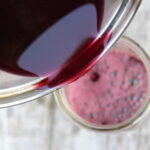Elderberry Juice
Elderberry juice is packed with nutrients and antioxidants, making it a popular choice for homemade remedies like syrups, jams, and juices. Whether you’re juicing fresh elderberries or dried, the process is simple and straightforward.
Servings: 2 servings (about 2 cups juice)
Ingredients
- 2 cups fresh elderberries or 1/2 cup dried elderberries
- 2 cups water for fresh berries, or 3-4 cups water for dried berries
- Optional: Sweetener to taste honey, maple syrup, etc.
Instructions
- If you’re using fresh elderberries, start by harvesting them from their stems. The berries grow in clusters, so you’ll need to pull the small berries off the larger stem clusters. Freezing the berries first makes this process much easier and cleaner, as it allows you to strip the berries off without mashing them. If you're using dried elderberries, you can skip this step, as they don't need to be stripped.
- After you’ve removed the berries from their stems, place them in a bowl of water and rinse gently to remove any dirt or debris. If you notice any leaves or small twigs, remove these as they can contribute a bitter taste to the juice. Make sure to only use the berries, as the stems and seeds are not suitable for consumption.
- Add the prepared elderberries to a medium-sized saucepan. If you’re using fresh elderberries, add 2 cups of water to the pot. If you’re using dried elderberries, add 3-4 cups of water. Bring the mixture to a boil, then reduce the heat and simmer for about 10 minutes for fresh elderberries, or 20 minutes for dried elderberries. During this time, the berries will break down and release their juice, turning the water a deep purple color.
- Once the berries have softened and the liquid has taken on a rich color, use a spatula or spoon to press the berries against the side of the pot to help release any remaining juice. After pressing, let the mixture simmer for an additional 5 minutes to ensure that all of the juice has been extracted.
- Remove the pot from the heat and let the berry mixture cool slightly. Then, strain it through a fine mesh strainer or cheesecloth placed over a bowl or large measuring cup. Use the back of a spoon or spatula to press the remaining pulp, extracting as much juice as possible. Be sure to discard the leftover pulp and seeds, as they aren’t suitable for consumption.
- (Optional) Elderberry juice can be quite tart, so you may want to sweeten it to taste. Stir in your preferred sweetener, such as honey, maple syrup, or another sweetener of your choice. Adjust the sweetness to your liking, and feel free to add other fruit juices, like apple or grape, to tone down the tartness and create a milder flavor.
- Once the juice is sweetened to your liking, pour it into clean bottles or jars. You can store your elderberry juice in the refrigerator for about 5-7 days. For longer storage, freeze the juice in ice cube trays and thaw individual portions as needed. Enjoy it chilled, mixed with other juices, or as a base for drinks and cocktails!
Notes
The yield is about 2 cups, whether using 2 cups fresh berries and 2 cups water, or when using 1/2 cup dried berries and 3-4 cups water.
Nutrition
Calories: 106kcal | Carbohydrates: 27g | Protein: 1g | Fat: 1g | Saturated Fat: 0.04g | Polyunsaturated Fat: 0.4g | Monounsaturated Fat: 0.1g | Sodium: 21mg | Potassium: 406mg | Fiber: 10g | Vitamin A: 870IU | Vitamin C: 52mg | Calcium: 62mg | Iron: 2mg
